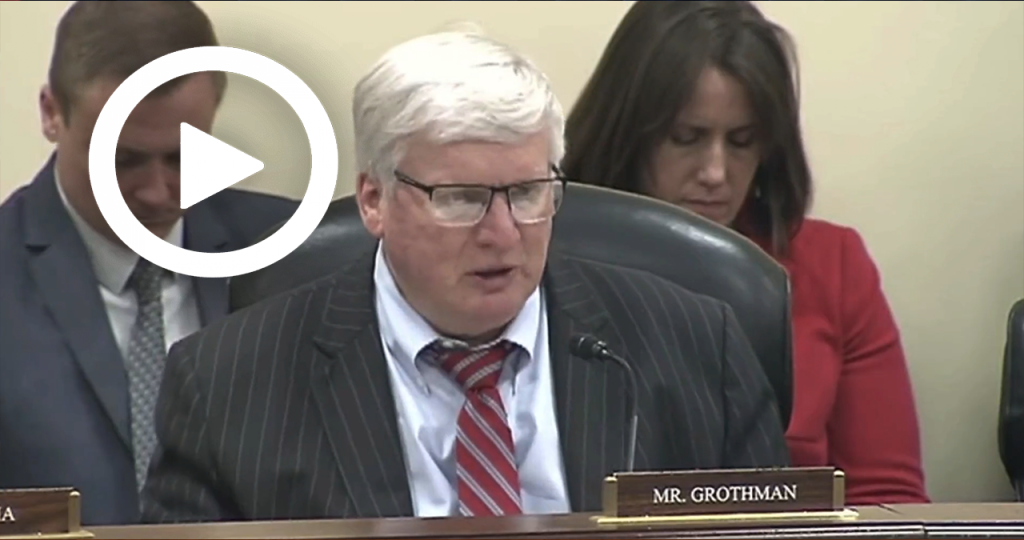Grothman: Force Multipliers Critical to Disrupting Criminal Organizations & Protecting Our Border
WASHINGTON — Subcommittee on National Security, the Border, and Foreign Affairs Chairman Glenn Grothman (R-Wis.) opened today’s subcommittee hearing by stressing the critical role force multipliers like canines and enhanced technology play in assisting U.S. Customs and Border Protection in stopping criminal activity at the U.S. southern border. Subcommittee Chairman Grothman highlighted how CBP seized enough fentanyl in FY 2022 to kill over three billion people and emphasized the importance of leveraging force multiplier technology to prevent deadly drugs from coming across the border. He concluded his remarks by thanking the witnesses for appearing before the subcommittee to provide testimony about technologies and resources utilized to make our nation safe at the border, ports of entry, and between ports of entry.
Below are Subcommittee Chairman Grothman’s remarks as prepared:
Good morning, and welcome to the Subcommittee on National Security, the Border, and Foreign Affairs’ first hearing of the 118th Congress.
I want to thank all our Members who are here today as we continue to conduct oversight of our Nation’s southern border.
Today, we are examining the technology being used by the Department of Homeland Security to disrupt transnational criminal organizations and protect our border, especially at our ports of entry.
I want to also thank our witnesses for being here today to testify on behalf of the Department.
In 2022, U.S. Customs and Border Protection seized a total of 656,000 pounds of illegal drugs including 155,000 pounds of marijuana, and 175,000 pounds of methamphetamine.
CBP also seized 14,700 pounds of illicit fentanyl. The lethal dose of fentanyl is only two milligrams, or the amount that fits on the tip of a pencil. This means CBP seized enough of the drug in FY 2022 to kill 3.3 billion people.
Unfortunately, the Centers for Disease Control and Prevention reported that in the 12-month period ending January 2022, more than 107,000 Americans died due to drug overdose, with almost 70 percent of those deaths resulting from deadly fentanyl trafficked across our southern border.
Make no mistake, we have a crisis at our southern border and in our communities with deadly narcotics like fentanyl coming in.
We must do everything in our power to disrupt the criminal organizations that traffic in death.
Today’s hearing is an opportunity to examine the technology and resources that work to keep our nation safe at the border, ports of entry, and between ports of entry.
Both Immigration and Customs Enforcement’s Homeland Security Investigations and CBP’s Office of Field Operations have a mission to combat transnational criminal activity and I am pleased to see both represented here today.
Emerging technologies such as illicit substance detection devices, facial recognition technology, or something as simple as canine units, help protect the U.S. from threats coming into our country.
In particular, I would like to highlight the work of CBP’s canine units.
CBP’s canine program works to detect explosives, controlled substances, large amounts of currency, and even illegal agricultural products.
The work of these canines and the use of other force multiplier technologies and resources allow our agents to perform their jobs in a safer and more efficient manner.
When I visit the border and ports of entry, I am consistently told by CBP officers that the K-9 units are one of the most valuable resources at their disposal.
Finally, I am interested in hearing more from the witnesses about their experience utilizing force multiplier technology.
There have been reports that some of these resources are not used effectively because of personnel issues.
Identifying patterns in which resources are not used effectively or properly is important for this Subcommittee to examine as we work to identify policy gaps.
I am increasingly concerned regarding reports that as record-breaking numbers of migrants cross our southern border, CBP officers and Border Patrol agents are spending more time processing migrant’s paperwork for release or parole than they are actually patrolling and protecting our borders.
We must also keep in mind that any given technology is only as effective as the manpower available to respond. A sensor doesn’t make an arrest or prosecute a case. It takes law enforcement personnel.
Today, I intend to explore these issues to examine where reforms can be tailored to provide the maximum return on investment.
After this hearing, I hope we will be able to identify the most vital technologies and resources utilized at the border and at ports of entry that allow border agents to be successful.
I also hope we can examine the need for the efficient use of personnel and resources to protect our national security from those wishing to impose harm on our country.
Thank you again to each of our witnesses for participating today, and I look forward to your testimony.
